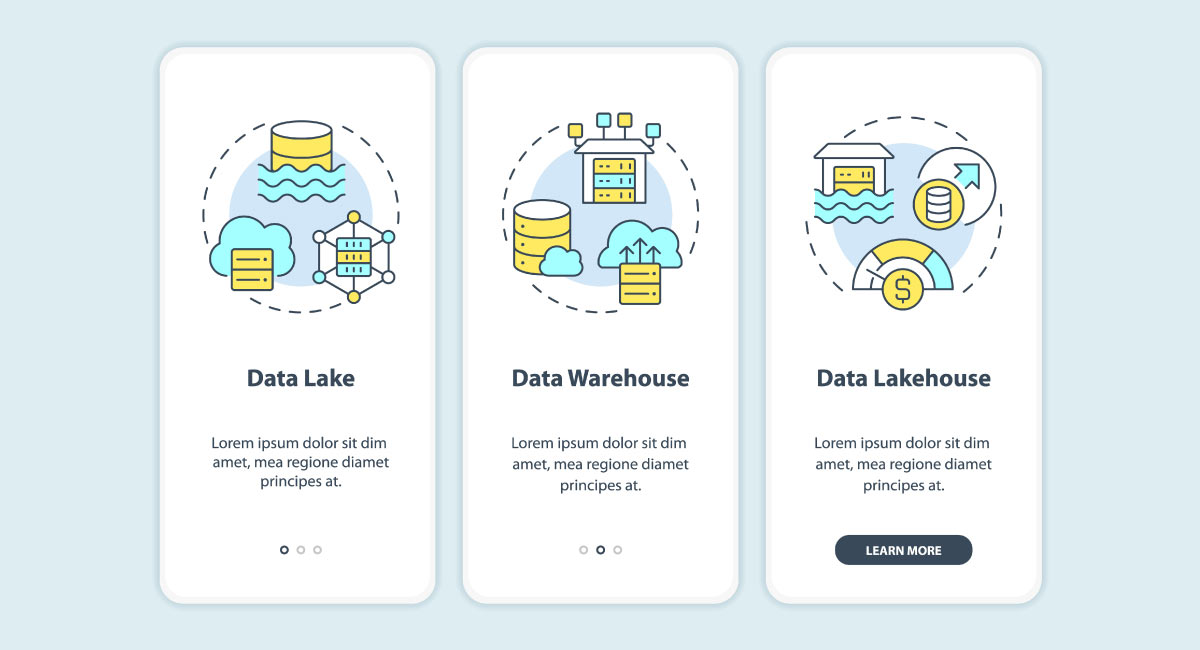We read more articles about how much data is generated every day. The volume is staggering. But have you ever considered how this spectacular amount of data is stored? Or, as comedian Steven Wright once observed, “You can’t have everything; where would you put it all?” So, where do we put our increasingly larger volumes of data and keep it in a way that’s easy to access?
This article compares two popular data storage methods: data lakes vs. data warehouses. Both storage methods were developed to handle massive amounts of big data, including management, storage, and handling.
We will explore the difference between data lakes and data warehouses, define each term, outline their benefits, show examples, and suggest situations where you should choose one over the other. We also share an online data analytics program for professional upskilling.
What is a Data Lake?
A data lake is a central storage space that stores all an organization’s structured or unstructured data. Consider it a vast data storage pool in a natural, raw state (like a lake). Data lake architectures can handle vast volumes of data that most organizations and businesses produce without structuring it first. Additionally, the information stored in a data lake can be used to construct data pipelines, making it available for data analytics tools to spot insights that can eventually inform critical business decisions and for AI and machine learning algorithms.
Also Read: Tutorial: Data Analysis in Excel
Data Lake Benefits
Here are some of the primary benefits of data lakes.
- Large quantities of both structured and unstructured data (e.g., ERP transactions or call logs) can be stored cost-effectively
- Keeping data in a raw state makes it available for use far faster.
- It can quickly and easily scale to store petabytes of data
- Broader data ranges can be analyzed in new ways, gaining unexpected and previously unavailable insights
Data Lake Examples
Common examples of data lakes include:
- Amazon S3. Also known as Amazon Simple Storage Service (S3), this resource is often used as a data lake due to its reliability, scalability, and flexibility in working with large volumes of data from many different sources.
- Azure Data Lake Storage. This storage option provides secure data lake functionalities built on Azure Blob Storage, optimized for analytics workloads.
Data Lake Use Cases
Data lakes are often used for:
- Big Data Analytics. Data lakes are perfect for storing and analyzing colossal amounts of raw data in real time.
- Machine Learning. Data lakes provide a rich, raw data source well-suited for training machine learning models.
Data Lake Usage Examples
- Education. The education field has started using data lakes to track data on student grades, attendance, and other performance metrics so that schools and universities can improve their policy and fundraising goals. Data lakes provide the right degree of flexibility to handle these sorts of data.
- Marketing. Marketing professionals can collect valuable, actionable data on their target customer demographic’s preferences by drawing from the many different sources in a data lake. Platforms like Hubspot store information in data lakes and present it to marketers in an attractive, easy-to-use interface. Data lakes allow marketers to analyze data, build data-driven campaigns, and make strategic decisions that have a greater chance of success.
- Transportation. Data lakes can be used when data scientists who work for airline and freight companies are responsible for cutting costs and increasing efficiency to support their organization’s lean supply chain management.
Also Read: Overview: What is Exploratory Data Analysis?
What is a Data Warehouse?
Data warehouses are specialized data management systems crafted to facilitate and improve business intelligence (BI) tasks, especially in analytics. They function as centralized depots that collate data from multiple sources into one single, unified repository. This arrangement permits the consolidation of contemporary and historical data, simplifying organization-wide analytical report generation.
Data warehouses deal only with structured, unified data. They are like a physical warehouse, where contents are stored, processed, organized into specific sections, and placed on labeled shelves.
Data Warehouse Benefits
Data warehouses provide advantages such as:
- It requires minimal to no data prep, making it considerably easier for analysts and business users to access and analyze the data
- Faster availability of accurate, complete data allows organizations to transform information into insights faster
- Unified, harmonized data provides a single source of truth, building confidence and trust in data insights and decision-making across all business lines
Data Warehouse Examples
Data warehouse examples include:
- Google BigQuery. This resource is a fully managed, serverless data warehouse that permits scalable analysis over large amounts of data.
- Snowflake. This cloud-based data warehouse offers a wide range of features suitable for data warehousing, like data sharing and scalability.
Data Warehouse Use Cases
Data warehouses are often used for:
- Business Intelligence. Data warehouses support reporting and data analysis, offering valuable insights for decision-making.
- Data Mining. Data warehouses facilitate patterns and relationship extractions from large datasets.
Data Warehouse Usage Examples
- Finance and banking. Financial institutions can use data warehouses to authorize anyone in the company to access data. Instead of generating reports using Excel spreadsheets, data warehouses can create accurate and secure reports, saving businesses time and money.
- Food and beverage. Large conglomerates such as PepsiCo or Nestlé rely on high-performance enterprise data warehouse systems, which empower them to run operations and consolidate sales, marketing initiatives, inventory control, and supply chain data conveniently located in one place.
Also Read: Data Analyst Job Description: What Aspiring Professionals Need to Know
Breakdown: Data Lakes vs. Data Warehouses
Let’s illustrate the difference between data lakes and data warehouses with this convenient table.
| Data Lakes | Data Warehouses | |
| Background | Data lakes are a relatively new concept for big data. | Data warehouses have been around for years. |
| Storage | Data lakes contain all the organization’s data in a raw, unstructured form. Data lakes can store this data for immediate or future use. | Data warehouses hold structured data that’s been cleaned and processed and made ready for strategic analysis based on the business’s predefined needs. |
| Users | Data from a data lake, consisting of large amounts of unstructured data, is usually used by data scientists and engineers who want to study data in its raw form to gain new, unique insights. | Data from a data warehouse is normally accessed by business-end professionals and managers looking to glean insights from business Key Performance Indicators (KPIs) since it is already structured to provide answers to pre-selected questions for analysis. |
| Accessibility | Data in a data lake is easily accessible and updatable. | Data in a data warehouse is complicated, making changes a problematic proposition. |
| Schema | Schema is defined after data is stored in a data lake rather than a data warehouse, which speeds up data capture and storage. | Schema is defined before the data is stored, lengthening the time it takes to process it. However, the data is ready for consistent, confident, organization-wide use once this is complete. |
| Analysis | Business intelligence (BI), big data analytics, data visualization, predictive analytics, and machine learning. | BI, data analytics, and data visualization. |
| Cost | Storage costs are relatively inexpensive in data lakes. They are also less time-consuming to manage, further reducing operational costs. | Data warehouses cost more than data lakes and require more time to manage, which translates into additional operational costs. |
| Processing | Data lakes process through ELT (Extract, Load, Transform). In this process, data is pulled from its source for storage in the data lake and then structured only when needed. | Data warehouses process through ETL (Extract, Transform, Load). In this process, data gets extracted from its sources, scrubbed, and structured so it’s ready for business-end analysis. |
When Do You Use Data Lakes vs. Data Warehouses?
Choosing between a data lake and a data warehouse hinges on your organization’s needs. You should consider factors like the type of data being managed, the data’s intended use, and the required processing capabilities. Data lakes are perfect for organizations storing large amounts of raw data and performing complex analytics and processing. On the other hand, data warehouses are best suited for companies and organizations that need fast, reliable access to processed, structured data for business intelligence and reporting purposes.
Learn More About Data Analytics
If you want to learn more about data analytics, consider taking this data analytics bootcamp as the first step in your educational journey. This 24-week online bootcamp gives you expertise in core data analytics skills and tools such as Excel, ETL, Generative AI, Power BI, Python, SQL, Tableau, among others.
Glassdoor.com shows that data analysts make an average annual salary of $83,745. So, check out this informative online class to prepare for a new career in our data-driven world (or upskill your current data analytics knowledge).
You might also like to read:
Data Analytics Certifications: Top Options
All About the Data Analyst Skills Professionals Need






